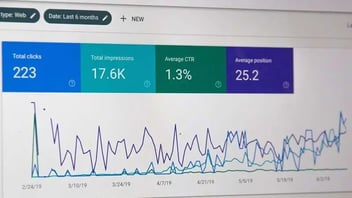Unlock SEO success: Learn how we use HubSpot Content Hub for SEO, boost rankings, increase organic traffic, and optimize our content for success.
Improve Website SEO? 10 Tips for Better Search Engine Rankings in 2026
If you're one of the few who have optimized your website and kept it that way, you have earned a vacation. Except that vacation will cost you since what "optimized" means seemingly changes by the minute. If you want your site to remain at peak performance SEO-wise, it takes constant vigilance; even the most conscientious businesses can fall behind immediately.

Why does SEO matter?
-
75% of all web traffic comes from organic search. If you want your website to be seen by potential customers, you need to optimize it for search engines.
-
Ranking drives traffic. The top organic search result on Google receives around 28.5% of all clicks, while the second receives roughly 15.7%. The CTR significantly drops for subsequent results, underscoring the importance of aiming for higher search engine rankings to improve CTR and increase organic traffic.
-
Google updates its search algorithm over 500 times per year. You must keep your website's SEO up-to-date and stay ahead of the competition. Google constantly updates its search algorithm, so you must maintain your website content to deliver the best possible experience for the visitor.
SEO takes time and effort. There is no quick fix for SEO, but persistence drives results. SEO is a long-term investment, and it can be a very rewarding one. If you want to improve SEO for your website, follow these tips to build a solid SEO foundation and increase traffic and lead conversions:
1. Conduct a Comprehensive Site Audit
Performing a comprehensive SEO audit for your website is evaluating a website's performance, identifying any shortcomings and areas for improvement, and ensuring that the website meets industry standards and best practices. It provides an objective view of a website's progress and state. A site audit ensures that work is conducted to a high standard and follows agreed-upon procedures.
To conduct a site audit, one can run their website URL through a site audit tool, which will crawl the website and generate a report of all the website issues.
Tip: Use a site audit tool to crawl your website and generate a report of all the website issues.
This will help you identify potential website performance, design, or content problems.
Here are some examples of site audit tools that you can use:
-
-
Ahrefs - Ahrefs Webmaster Tools (AWT) is free and a great start!
-
-
-
Google Search Console (free), one of the leading webmaster tools
-
Semrush
-
-
-
Moz
-
2. Keyword Research and Optimization
Keyword optimization refers to researching, analyzing, and selecting keywords for a website to increase visibility in search engines and drive more qualified traffic to the site. Keyword research is essential to this process and is the first step in SEO copywriting. This research aims to determine the search terms a target audience uses, which are then used as keywords for the site.
Keyword optimization includes researching keywords relevant to the target audience, business, and site content and selecting keywords with the highest probability of driving targeted traffic to the site.
The above-mentioned audit tools are also well-positioned to support your keyword research. Google Keyword Planner is an additional recommendation.
You might also like:
3. Enhance Website Content with High-Quality, Relevant, and Unique Content
High-quality website content enhances a website's overall performance and success. This type of content is characterized by being original, relevant, and helpful to the audience. It should provide vital information for users and be engaging to keep visitors interested. Website content can include written copy, visuals, and audio or video elements.
The quality of the content on a site also impacts website usability. Good website content contributes to the ease of use, navigation, and accessibility of information on the site.
On the other hand, poor-quality content is often produced quickly in bulk, aiming to improve website rankings. This content often lacks essential information and is not engaging to visitors. Providing high-quality, relevant, and unique content that fits the target audience's interest ensures a website gets constant and recurring traffic.
4. Improve Website Speed and User Experience
Improving website speed and user experience is essential to attracting traffic and retaining visitors. The following steps can be taken to improve website performance and enhance the user experience:
-
Test website performance using website speed tests
-
Improve website speed by compressing images, making the website responsive and mobile-friendly, and optimizing landing pages.
-
Implement UI/UX design practices, optimize content marketing, fix technical SEO issues, prioritize mobile-friendliness, and follow web accessibility best practices.
Speed and user experience are core ranking criteria within Google Search.
5. Make Use of Header Tags and Structured Data
Header tags separate headings and subheadings on a webpage to improve readability and SEO. There are six header tags, ranked in order of importance from H1 to H6, with H1s usually being the post's title.
Structured data is information coded using in-page markup that describes the content of a page and is applied to the page that the information refers to. It is essential not to create blank or empty pages just to hold structured data or to add structured data about information that is not visible to the user. Google Tag Manager can generate structured data by setting it up on your site, adding a new custom HTML tag to the container, and pasting the desired structured data into the tag.
6. Optimize Images and Videos for Search Engines
Images and videos can be crucial in optimizing search engine content. Images and videos support the range and make it easier for users to read and consume, potentially increasing dwell time on a page. To optimize images for load speed, resize images, use proper image formatting, pick a suitable file name, and add appropriate metadata.
Quality backlinks are votes of confidence in your website's content and are essential for improving your search engine ranking. The more high-quality backlinks you have, the more valuable and credible your website is considered to be by search engines.
7. Build Quality Backlinks
To build high-quality backlinks, consider the following strategies:
-
Create Skyscraper/Pillar Content. A Pillar Page content strategy involves creating in-depth, comprehensive, and highly informative articles or blog posts that establish your website as an authority in a particular industry or niche. Skyscraper content covers a specific topic in great detail and provides valuable insights and information to the reader.
-
Become a source for reporters and bloggers. When you are a source for reporters and other bloggers, it not only establishes you as an authority in your field, it often earns you a backlink from the finished blog or article. Be sure to ask to have your site linked when you agree to become a source.
-
Use content formats that generate links. This means creating content that's meant to be shared and linked to. How-to guides, informative articles, tips, hints, tricks, and other pieces that get people thinking are shared frequently.
-
Optimize anchor text. Link building isn't just about inserting hyperlinks in every other word. Links should direct the reader to context-relevant, additional detail as appropriate. Use anchor text that signals what to expect when clicking the link. There must not be a bait-and-switch to direct readers and search engines to irrelevant pages.
Link building can be done by growing the number of links to your websites and within a website (internal linking). Common tactics that fall under this category include the following:
-
Guest posting
-
Link exchange
-
Broken link building
-
Resource page link building
-
Internal link building. The easiest of them all.
8. Utilize Social Media for Link Building and Brand Awareness
Utilizing social media can be an effective way to build brand awareness and links. Building brand awareness on social media involves creating an online presence and connecting with your target audience to generate impressions and positive perceptions of your brand. To increase brand awareness through social media, you should know your target audience and create a marketing strategy to create a positive brand perception and add value. Utilizing social media for link building involves leveraging the popularity and reach of social media platforms to gain backlinks from other websites to your own, which can improve your search engine ranking.
9. Monitor and Analyze Website Traffic and Rankings
Monitoring and analyzing website traffic and rankings are essential for website management and optimization.
To maximize marketing spending, website traffic analysis helps focus on target market segments with the highest conversion and lowest bounce rate. The goal is to understand the flow and activities of users on the site and identify areas for improvement. Google Search Console and Google Analytics will give you insights about the metrics that matter to Google.
Website ranking traffic refers to traffic that comes to a website from search engine rankings or search engine result pages. For example, when someone clicks a link to a page on the website after searching in Google, it contributes to search traffic. Measuring website ranking traffic helps understand the effectiveness of the website's search engine optimization (SEO) efforts.
10. Stay Up-to-Date with SEO Best Practices and Updates
Changes in search algorithms are meant to provide better, more relevant information to users, and SEO professionals must constantly adapt to these changes. Following industry news, reading blogs, listening to marketing podcasts and other outlets can help you stay current on the best practices and updates in Search Engine Optimization (SEO). Staying updated in the SEO industry, including following industry experts, attending conferences and events, reading industry blogs and news, and testing new techniques and strategies. With the right resources and tips, staying on top of the ever-changing SEO landscape is easier than ever.
SEO Improvement FAQs:
The most important SEO factors vary depending on the specific search engine and the type of website. However, some of the most important factors include:
- Content quality. Creating good content for your website is one of the most important factors for SEO.
- Keyword usage. The use of relevant keywords throughout your website's content is also important.
- Backlinks. The number and quality of backlinks to your website is another crucial factor.
- Website speed. The speed of your website is also important for SEO.
It's essential to update your site's content regularly. This will help to keep your website fresh and relevant in the eyes of visitors and search engines. How often you update your content will depend on your website type and your target audience. However, a good rule of thumb is to update your content at least once a quarter.
Keyword research is the process of finding the best keywords to use on your website. This involves identifying the keywords your target audience is searching for and using those keywords throughout your website's content.
Schema markup is a type of code that you can add to your website's HTML. It helps search engines understand the meaning of your website's content, which can improve your SEO. Twitter card markup, Open Graph markup, and FAQ markup are example use cases for schema markup.
There are several ways to add schema markup to your site; you can use a schema markup generator or a WordPress plugin.
This content is also available in:
- German: Website-SEO verbessern? 10 Tipps für Search Engine Rankings in 2026
- Spanish: Consejos para Mejorar el SEO de tu Sitio Web en 2026
- French: 10 conseils pour améliorer le référencement SEO de votre site web
- Italian: Migliorare la SEO del sito web? 10 consigli per il 2026
- Romanian: Optimizare SEO site: 10 sfaturi pentru clasări mai bune în 2026
- Chinese: 提高网站搜索引擎优化? 2026 年提高搜索引擎排名的 10 个技巧









Leave a Comment